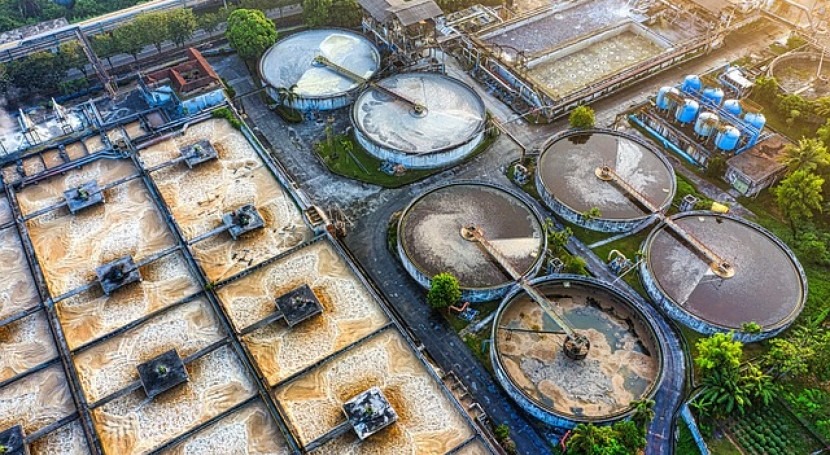Strategic Approaches to Boost Waste Water Therapy Effectiveness and Decrease Environmental Effect
In the realm of waste water therapy, the quest for improved performance and minimized ecological effect is a continuous challenge that demands critical solutions. The integration of sophisticated therapy modern technologies, energy-efficient processes, source healing techniques, enhanced nutrient removal strategies, and wise surveillance and control systems stands for a diverse framework for addressing these pushing concerns.
Advanced Therapy Technologies
Sophisticated membrane layer filtering systems have reinvented advanced wastewater therapy procedures, considerably improving the elimination of contaminants. This innovation has actually confirmed to be extremely efficient in getting rid of a broad array of contaminants, including drugs, hefty steels, and natural compounds, which are often challenging to eliminate with conventional treatment methods.
Furthermore, membrane purification systems provide numerous benefits over traditional therapy techniques. Additionally, these systems are very flexible and can be easily incorporated into existing therapy plants or used as standalone devices for decentralized applications.
Energy-Efficient Processes
The integration of energy-efficient procedures in wastewater treatment systems is important for optimizing resource application and minimizing functional expenses. One vital approach to enhancing energy effectiveness in wastewater therapy is the application of advanced aeration systems, such as fine bubble diffusers or surface aerators, which can improve oxygen transfer efficiency and decrease energy usage.
Moreover, maximizing procedure control and automation via making use of innovative sensors and keeping track of systems can improve general energy effectiveness by changing procedures in real-time based on actual demand and conditions. Implementing energy audits and frequently keeping an eye on energy performance indicators are vital methods to identify areas for renovation and track energy-saving campaigns properly. On the whole, the fostering of energy-efficient processes in wastewater treatment not only profits the setting however likewise adds to long-term price financial savings and functional sustainability.
Source Healing Techniques
With a concentrate on optimizing source utilization and sustainability in wastewater therapy systems, the execution of source healing methods becomes a critical aspect in enhancing operational efficiency. Source healing strategies in wastewater therapy include the recognition and removal of valuable sources from the waste stream, thus turning what was as soon as thought about waste right into an important possession. By carrying out source healing strategies such as nutrient removal and healing, energy generation from natural issue, and the production of reusable water, wastewater treatment plants can reduce ecological impact while optimizing effectiveness.

Improved Nutrient Elimination Strategies
Executing innovative nutrient removal methods is important for maximizing the performance of wastewater therapy systems. Enhanced nutrient elimination plays an important function in reducing the ecological effect of treated effluent discharged right into water bodies. One of the key strategies utilized for enhanced nutrient elimination is the process of organic nutrient removal (BNR), which entails the elimination of nitrogen and phosphorus with biological procedures. This can be accomplished through using specialized bacteria that can convert nitrogen substances into inert nitrogen gas via denitrification, and collect phosphorus within their cells through a procedure called enhanced organic phosphorus removal (EBPR)

In enhancement to BNR, advanced therapy methods such as membrane layer bioreactors (MBRs) and created marshes can additionally be used to boost nutrient elimination effectiveness. By integrating these sophisticated nutrient elimination methods into wastewater treatment municipalities, industries and systems can effectively reduce nutrient Our site air pollution and shield the setting.
Smart Tracking and Control Systems
Making use of sophisticated modern technology, the combination of wise monitoring and control systems changes the functional effectiveness of wastewater treatment facilities. These systems include sophisticated sensors and information analytics to constantly keep track of key criteria such as pH levels, turbidity, liquified oxygen, and circulation rates in real-time. By accumulating and assessing this data, operators can get important insights right into the performance of the therapy processes, enabling positive adjustments to maximize therapy efficiency.
Smart surveillance and control systems also sustain remote tracking capabilities, enabling operators to accessibility real-time data and control features from off-site places. This remote availability boosts functional versatility and responsiveness, allowing swift treatments in situation of system malfunctions or fluctuations in influent top quality. Additionally, the predictive upkeep abilities of these systems help stop tools failings and lessen downtime, eventually enhancing the overall integrity of wastewater therapy operations (Waste Water Treatment).
Final Thought
To conclude, tactical approaches such as sophisticated therapy technologies, energy-efficient processes, resource recuperation strategies, enhanced nutrient removal methods, and wise surveillance and control systems play an essential function in improving wastewater treatment effectiveness and lessening ecological influence. By applying these strategies, wastewater therapy plants can boost their total efficiency, lower power intake, recover valuable resources, and ensure compliance with environmental regulations. These approaches are important for sustainable and efficient wastewater administration methods.

In verdict, tactical strategies such as sophisticated treatment modern technologies, energy-efficient processes, source healing strategies, enhanced nutrient elimination strategies, and wise surveillance and control systems play an important role in enhancing wastewater treatment efficiency and lessening ecological impact.